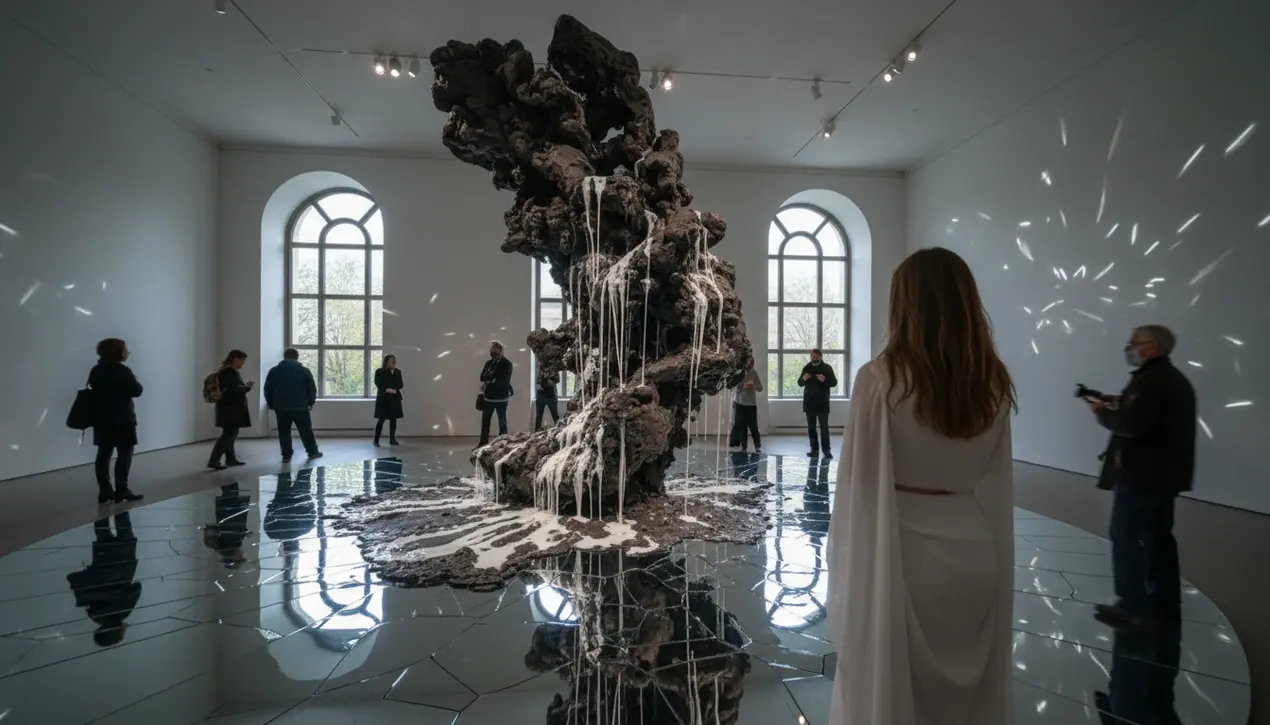
Entertainmenttheatre & artsArt Exhibitions
In ‘Dripping Earth,’ Cannupa Hanska Luger Ushers the Past into a Speculative Future
NA
Natalie Cooper
3 hours ago7 min read2 comments
Step into the Joslyn Art Museum, and you’re not just entering a gallery; you’re stepping onto a stage where time itself is the lead performer in Cannupa Hanska Luger’s solo exhibition, 'Dripping Earth. ' This isn't merely a collection of artifacts; it’s a profound theatrical production where history, memory, tradition, and speculative future converge in a haunting, beautiful symphony.Luger, a visionary artist of Mandan, Hidatsa, Arikara, and Lakota heritage, masterfully directs this narrative, using clay, fiber, and reclaimed materials not as mere mediums but as actors in a grand, unfolding drama. The central installation, from which the exhibition draws its name, features earthen forms that appear to be in a state of perpetual flux—melting, reforming, and dripping with the weight of ancestral knowledge and future possibilities.It’s as if the very soil is speaking, its voice a low, resonant hum that echoes through the museum’s halls, challenging the sterile silence typically associated with such spaces. This work doesn’t just hang on the wall; it inhabits the room, demanding a visceral, emotional response from the audience, much like a powerful monologue that leaves you breathless.Luger’s process is deeply rooted in Indigenous methodologies, where creation is a collaborative, community-engaged act, reminiscent of a theatrical troupe building a production from the ground up. He often involves the public in the making, transforming viewers into participants, blurring the line between observer and performer in a way that feels both ancient and urgently contemporary.This approach critiques the Western art historical canon’s obsession with the solitary genius, instead proposing a model of shared authorship and collective memory. The exhibition’s speculative dimension is its most compelling act; it doesn’t offer a dystopian or utopian prophecy but presents a ‘what if’ scenario where Indigenous knowledge systems and their understanding of cyclical time are not relegated to the past but are central to navigating an uncertain future.In one series, ceramic vessels are fractured and repaired with materials like brass and mirror, creating a visual metaphor for resilience—a history of breakage and beautiful, intentional mending. This act of ‘kintsugi’ on a cultural scale speaks to a future built not on erasure but on acknowledging and honoring scars.The timing of this exhibition is particularly poignant, arriving amidst a broader cultural moment where institutions are grappling with their colonial legacies and the need for genuine decolonization of their collections and narratives. The Joslyn, by platforming Luger’s work, is effectively staging a crucial conversation, one that moves beyond tokenistic inclusion to a deeper, more challenging engagement with Indigenous futurisms.Critics and curators alike are hailing 'Dripping Earth' as a landmark show, not just for its aesthetic power but for its philosophical heft. It asks us to reconsider our relationship with time—to see it not as a linear arrow but as a spiral, where the past is always present, and the future is already being shaped by the stories we choose to carry forward. To experience this exhibition is to witness a masterful performance where every element, from the texture of the clay to the play of light on a mirrored surface, is a carefully crafted line in a play about survival, memory, and the relentless, dripping persistence of the earth itself.
#featured
#Cannupa Hanska Luger
#Dripping Earth
#Joslyn Art Museum
#contemporary art
#Indigenous art
#speculative future
#sculpture
Stay Informed. Act Smarter.
Get weekly highlights, major headlines, and expert insights — then put your knowledge to work in our live prediction markets.
Comments
Loading comments...
© 2025 Outpoll Service LTD. All rights reserved.